Tuesday, May 08, 2007
Hybrid Field Target
The first field targets I made to start my first field target club were made of wood. The wood design has a lot of advantages which I detailed in my last blog. In recent years I have duplicated the wood target design using all metal components. These targets seem to be more finicky about the setting of the sear. If set too light, they would fall with a faceplate hit, but when set heavy enough to stop the face fall, they wouldn't fall with a lower powered rifle.
I have a big turkey target that I call Big Tom. Over the winter I decided to rework Big Tom's action to use the wood target design. After completing the rework there was a sweet spot on the target face just below the kill zone that when hit would cause the target to fall over. I sat and thought about it for a while and realized that most of the sweet spots on my metal targets were located below the kill zone. I theorized that the face must be bowing to some degree when hit so the face needed to be stiffened. I also know from past experience that the vibrations caused from the pellet strike to the face played a part in face falls. My wood targets didn't have this problem.
I figured that the wood face plate probably was absorbing the vibrations better and was stiffer. So I decided to glue a piece of plywood to the back of Big Tom and voila! Problem solved. The sweet spot was gone and I could set the sear trip level down lower so that a 10 ft. lb. rifle could knock it over out to 55 yards. This got me to thinking again.
One of the down sides to the wood targets is that the wood faceplate gets beat up when shooters miss the kill zone washer. After a season or two the face can really start to look bad. So I thought, when not make a hybrid target that has a metal face that is attached to a wood action and have the best of both worlds. The wood targets are easy to make and repair and the metal face has the advantage of the wood backer not getting beat up. I found a smaller bird target that I made like this back in the '90s and it still works well.
With a little planning and some rework of my faceplate designs, I think a standard wood faceplate backer could be made that would fit any of the target faces. This would allow one target base to be made that any of the faces could be attached to. The may need to be a large and small version but I think this would be a really easy and simple way to mass produce targets at a pretty inexpensive cost and that may ease the cost of getting a new club started. As time permits, I am going give this design a try.
I have a big turkey target that I call Big Tom. Over the winter I decided to rework Big Tom's action to use the wood target design. After completing the rework there was a sweet spot on the target face just below the kill zone that when hit would cause the target to fall over. I sat and thought about it for a while and realized that most of the sweet spots on my metal targets were located below the kill zone. I theorized that the face must be bowing to some degree when hit so the face needed to be stiffened. I also know from past experience that the vibrations caused from the pellet strike to the face played a part in face falls. My wood targets didn't have this problem.
I figured that the wood face plate probably was absorbing the vibrations better and was stiffer. So I decided to glue a piece of plywood to the back of Big Tom and voila! Problem solved. The sweet spot was gone and I could set the sear trip level down lower so that a 10 ft. lb. rifle could knock it over out to 55 yards. This got me to thinking again.
One of the down sides to the wood targets is that the wood faceplate gets beat up when shooters miss the kill zone washer. After a season or two the face can really start to look bad. So I thought, when not make a hybrid target that has a metal face that is attached to a wood action and have the best of both worlds. The wood targets are easy to make and repair and the metal face has the advantage of the wood backer not getting beat up. I found a smaller bird target that I made like this back in the '90s and it still works well.
With a little planning and some rework of my faceplate designs, I think a standard wood faceplate backer could be made that would fit any of the target faces. This would allow one target base to be made that any of the faces could be attached to. The may need to be a large and small version but I think this would be a really easy and simple way to mass produce targets at a pretty inexpensive cost and that may ease the cost of getting a new club started. As time permits, I am going give this design a try.
Wood Field Target
It was September of 1995, I was sitting one Saturday morning on the practice range waiting. Waiting for anyone to show up to my very first match. I had started the field target discipline at the Port Malabar Rifle and Pistol Club in Palm Bay Florida and now I was waiting to see if anyone showed up for the inaugural match. The PMR&PC board of directors gave me $50 to buy supplies and make some targets to try to get this venture going. From that money, I bought some string, spikes and enough materials to make 10 wood based field targets . I had one guy show up, Bud Yeager. He and I went into the woods and shot our match at my 10 wood targets and had a great time.
The simple wood targets worked great that day and have continued to serve me well to this very day. I still have most of those original ten targets today and they still work great. I made a bunch more targets after that day and I still have a lot of them too. I still use the old wood targets from time to time, however I hesitated to leave them out in the elements all the time.
With my recent adventures into low powered airgunning I decided to get a couple of my old wood target and use them at home to practice with my 10 meter match rifles. I thought I would have to adjust the sears to allow them to fall over with a lower powered rifle, but, to my surprise the targets were already set to fall with just 1.5-2 ft. lbs. of energy! I hadn't realized that these old targets would trip so easily yet would take the impact of a 20 ft. lbs. rifle without falling. I had a much better design than I realized!
In the olden days, I tended to use scrap wood for my targets and most of it was untreated wood. The wood would swell if it was left out in the rain which caused the sear pressure to change. Once it dried out the sear would return to normal. At a few matches I had to adjust some targets on the morning before the match after a night rain. It never occurred to me that I might use marine plywood and pressure treated bases to make the targets and then slather all the parts with some water sealant before final assembly. This may help weather proof the targets and allow them to set out in the elements all season like my metal targets. I think once I get settled into my new home that I may have to make a few more wood target out of better materials. Then I will torture test them over the next year to see just how well they hold up in the harsh southern climate.
Here are a few wood targets I made over the years:
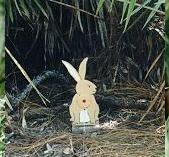
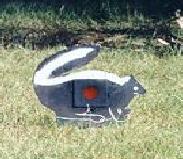
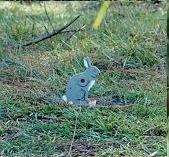
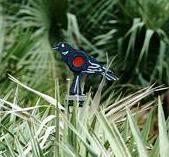
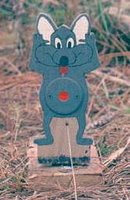
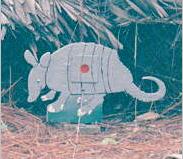
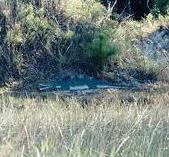

The simple wood targets worked great that day and have continued to serve me well to this very day. I still have most of those original ten targets today and they still work great. I made a bunch more targets after that day and I still have a lot of them too. I still use the old wood targets from time to time, however I hesitated to leave them out in the elements all the time.
With my recent adventures into low powered airgunning I decided to get a couple of my old wood target and use them at home to practice with my 10 meter match rifles. I thought I would have to adjust the sears to allow them to fall over with a lower powered rifle, but, to my surprise the targets were already set to fall with just 1.5-2 ft. lbs. of energy! I hadn't realized that these old targets would trip so easily yet would take the impact of a 20 ft. lbs. rifle without falling. I had a much better design than I realized!
In the olden days, I tended to use scrap wood for my targets and most of it was untreated wood. The wood would swell if it was left out in the rain which caused the sear pressure to change. Once it dried out the sear would return to normal. At a few matches I had to adjust some targets on the morning before the match after a night rain. It never occurred to me that I might use marine plywood and pressure treated bases to make the targets and then slather all the parts with some water sealant before final assembly. This may help weather proof the targets and allow them to set out in the elements all season like my metal targets. I think once I get settled into my new home that I may have to make a few more wood target out of better materials. Then I will torture test them over the next year to see just how well they hold up in the harsh southern climate.
Here are a few wood targets I made over the years:








 American Airguns Blog
American Airguns Blog